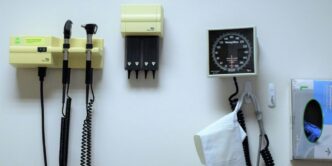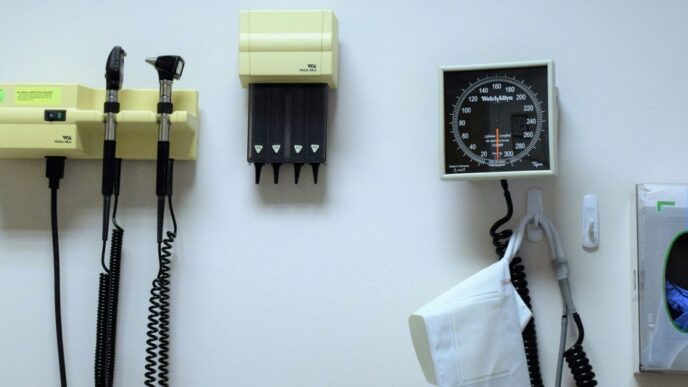The sciatic nerve is the longest nerve in the human body, running from the lower back all the way down the leg. It is responsible for the movement and sensation of the leg, and can become irritated or compressed, causing pain.
The sciatic nerve begins in the lower back, where it runs through the sciatic notch. It then runs down the back of the leg, through the buttocks and the back of the knee. It then splits into two nerves, the tibial nerve and the peroneal nerve, which run down the rest of the leg.
The sciatic nerve can become compressed or irritated at any point along its length. This can happen due to a variety of reasons, such as a herniated disc, spinal stenosis, or a tumor. When this happens, it can cause pain that radiates down the leg. This is known as sciatica.
Sciatica can be a very painful condition. Treatment typically involves pain relief and physical therapy. In some cases, surgery may be necessary to relieve the pressure on the nerve.
-What are the symptoms of sciatic nerve pain?
Sciatic nerve pain is a common problem that can be caused by a number of different things. The most common cause is a herniated disc, but it can also be caused by other things like spinal stenosis or a pinched nerve.
The pain is caused by pressure on the sciatic nerve, which runs from the lower back down the leg. The pain can be a dull ache, or it can be a sharp, shooting pain. It can be felt in the lower back, buttocks, and down the leg.
The pain is often worse when sitting or standing for long periods of time. It can also be worse when coughing or sneezing.
There are a number of things that can be done to relieve the pain. These include over-the-counter pain medications, stretching exercises, and physical therapy. In some cases, surgery may be necessary to relieve the pressure on the sciatic nerve.
-What are the causes of sciatic nerve pain?
Sciatic nerve pain is one of the most common and debilitating forms of pain affecting millions of people around the world. The sciatic nerve is the longest and widest nerve in the body, running from the lower back down the legs. Sciatic nerve pain can be caused by a variety of factors, including herniated disks, spinal stenosis, and pregnancy.
One of the most common causes of sciatic nerve pain is a herniated disk. A herniated disk occurs when the gel-like center of a disk in the spine ruptures and puts pressure on the sciatic nerve. This can cause severe pain that radiates down the leg.
Spinal stenosis is another common cause of sciatic nerve pain. This condition occurs when the spaces in the spine narrow, putting pressure on the spinal cord and nerves. This can lead to pain, numbness, and tingling in the legs and buttocks.
Pregnancy is another common cause of sciatic nerve pain. As the baby grows, it can put pressure on the sciatic nerve, causing pain that radiates down the leg.
There are many other potential causes of sciatic nerve pain, including muscle tears, spinal tumors, and diabetes. Treatment for sciatic nerve pain depends on the underlying cause. In some cases, rest, ice, and over-the-counter pain medications may be enough to relieve the pain. In other cases, more aggressive treatment, such as physical therapy, epidural injections, and surgery, may be necessary.
-How is sciatic nerve pain diagnosed?
Sciatic nerve pain is a common condition that can cause a sharp, burning sensation in the lower back, buttocks, and legs. The sciatic nerve is the longest nerve in the body, and it runs from the lower back down the legs. When this nerve is pinched or irritated, it can cause pain.
There are several ways to diagnose sciatic nerve pain. A doctor will usually start by taking a medical history and doing a physical examination. They may also order imaging tests, such as an MRI, to rule out other conditions.
If the cause of the pain is not clear, a doctor may also recommend nerve testing. This can help to determine if the sciatic nerve is being pinched or irritated. Nerve testing can be done with electrical stimulation or by injecting a local anesthetic into the area around the sciatic nerve.
Sciatic nerve pain can be treated with over-the-counter pain relievers, physical therapy, and stretching exercises. In some cases, surgery may be necessary to relieve the pressure on the sciatic nerve.
-How is sciatic nerve pain treated?
Sciatic nerve pain is treated with a variety of methods, depending on the underlying cause. In most cases, a combination of treatments is necessary to achieve optimal results.
The first step in treating sciatic nerve pain is to identify the underlying cause. Once the cause is determined, specific treatments can be recommended.
Common treatments for sciatic nerve pain include:
– Physical therapy: Physical therapy can help to stretch and strengthen the muscles that support the spine and improve range of motion.
– Heat and ice: Applying heat or ice to the affected area can help to reduce pain and inflammation.
– Pain medication: Over-the-counter or prescription pain medication may be necessary to control pain.
– Steroid injections: In some cases, steroid injections may be recommended to reduce inflammation.
– Surgery: In rare cases, surgery may be necessary to correct the underlying cause of sciatic nerve pain.
If you are experiencing sciatic nerve pain, it is important to consult with your doctor to determine the best course of treatment.
-Can sciatic nerve pain be prevented?
The sciatic nerve is the longest nerve in the human body, running from the lower back all the way down the legs. This nerve is responsible for providing sensation to the legs and feet, as well as muscle control. Sciatic nerve pain, also known as sciatica, is a common condition that occurs when the nerve becomes compressed or irritated.
There are a number of things that can cause sciatic nerve pain, including a herniated disc, spinal stenosis, and pregnancy. While there is no surefire way to prevent sciatic nerve pain, there are some things you can do to lower your risk.
If you have a herniated disc or spinal stenosis, you may be more likely to experience sciatic nerve pain. These conditions can be caused by a variety of things, including aging, injury, and obesity. While you may not be able to prevent these conditions entirely, you can take steps to lower your risk. For example, you can maintain a healthy weight, exercise regularly, and avoid smoking.
If you are pregnant, you may also be at a higher risk for developing sciatic nerve pain. This is because the added weight of the baby can put pressure on the nerve. Additionally, the hormones released during pregnancy can relax the ligaments and muscles in the body, which can also lead to sciatic nerve pain. While you cannot prevent pregnancy, you can take steps to reduce your risk. For example, you can engage in regular prenatal care, exercise regularly, and maintain a healthy weight.
There are a number of things you can do to help prevent sciatic nerve pain. First, you can maintain a healthy weight. This will help reduce the amount of pressure on your spine and lower your risk for a herniated disc or spinal stenosis. You can also exercise regularly. This will help keep your muscles and ligaments strong and prevent them from becoming relaxed and causing sciatic nerve pain. Additionally, you can avoid smoking. Smoking can cause a number of health problems, including a herniated disc and spinal stenosis.
Read also https://combineclinic.com/













